Apple iPhone 4S: Thoroughly Reviewed
by Anand Lal Shimpi & Brian Klug on October 31, 2011 7:45 PM EST- Posted in
- Smartphones
- Apple
- Mobile
- iPhone
- iPhone 4S
Faster Throughput on WCDMA
Fixing unintended attenuation is only one part of what’s new however, the other part of the story is faster cellular connectivity for users on WCDMA/UMTS carriers. Users who are using the 4S on CDMA (like Sprint or Verizon) won’t see a performance difference since this is still the same EVDO Rev.A.
The iPhone 4 used an Intel/Infineon X-Gold 618 which supported HSDPA 7.2 and HSUPA 5.76. The MDM6610 inside the 4S supports HSDPA 14.4 and HSUPA 5.76, alongside a number of 3GPP Rel.7 features which are colloquially known as HSPA+. I talked about this extensively in another piece when there was some confusion about whether or not the 4S is HSPA+ - which it is.
| iPhone Cellular Speeds | ||||
| Property | iPhone 3G/3GS | iPhone 4 (GSM/UMTS) | iPhone 4 (CDMA) | iPhone 4S |
| Baseband | Infineon X-Gold 608 | Infineon X-Gold 618 | Qualcomm MDM6600 | Qualcomm MDM6610 |
| HSDPA | Cat.8 - 7.2 Mbps | Cat.8 - 7.2 Mbps | N/A | Cat.10 - 14.4 Mbps |
| HSUPA | None - 384 Kbps WCDMA only | Cat.6 - 5.76 Mbps | N/A | Cat.6 - 5.76 Mbps |
| EVDO | N/A | N/A | 1x/EVDO Rev.A | 1x/EVDO Rev.A |
The previous X-Gold 618 baseband was a nice improvement over the iPhone 3G/3GS’ X-Gold 608, which lacked HSUPA, but in a world where most WCDMA carriers are at least running HSDPA 14.4, it’s nice to finally have an iPhone with something faster than HSDPA 7.2. I’ve done lots of testing inside my Tucson, AZ market (which is “4G” HSPA+ on AT&T’s coverage viewer) with both the 4 and the 4S, and have built a very good feel for the 4’s performance. As a reminder, if you’re in the USA, those dark blue areas represent HSPA+ coverage areas with AT&T’s upgraded backhaul. In practice these are at least HSDPA 14.4.

Left: iPhone 4 Limited to ~6.1 Mbps down, Right: iPhone 4S (same location) hitting ~9 Mbps
With line of sight to an AT&T NodeB inside my HSPA+ market I’m used to seeing a maximum downstream throughput on the iPhone 4 of almost exactly ~6.1 Mbps, which is about right for the 4’s HSDPA 7.2 maximum when you include overhead. The nice straight line in that result should clue you in that downstream throughput on the 4 was being gated by the baseband. On the 4S, in this same location, I’ve been able to get 9.9 Mbps when the cell isn’t loaded at night (I didn't grab a screenshot of that one, for some reason). It’s nice to finally not be gated by the baseband anymore on an iDevice. Having a faster baseband is part of the reason the 4S’s cellular performance is much better, the other half is receive diversity which helps the 4S push these high throughput rates, and also dramatically improve performance at cell edge.
I did some drive testing with the 4 and 4S side by side and targeted areas that I know have pretty poor signal strength. The 4S is shown in yellow, the 4 in blue.
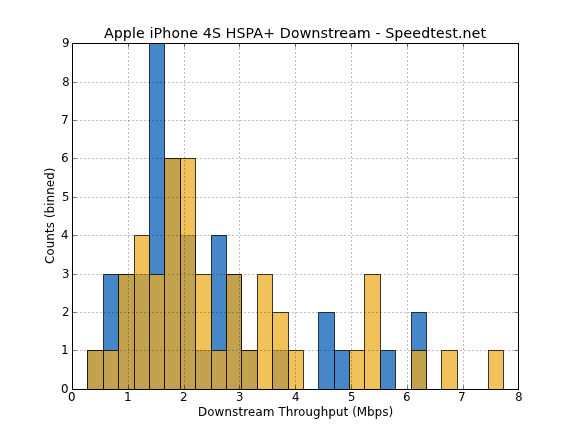
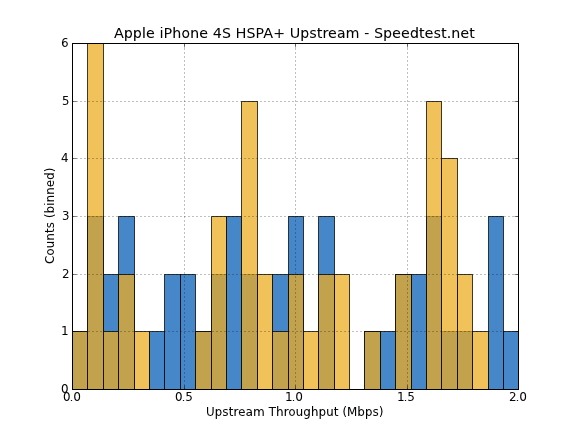
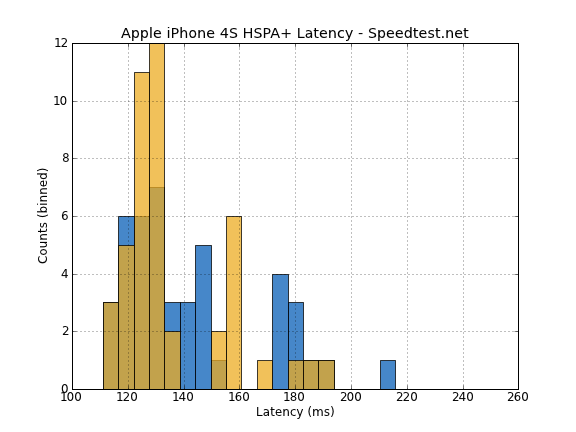
You can see how downstream throughput gets a nice shift up, and the average changes as well, from 2.28 Mbps on the 4 to 2.72 Mbps on the 4S. The maximum in this sample increases from 6.25 to 7.62 Mbps as well. It isn’t a huge shift, but subjectively I’ve noticed the 4S going a lot faster in areas that previously were difficult for the 4.
We’ve also run the usual set of standalone tests on the 4S on AT&T in my market of Tucson, AZ, in Anand’s market of Raleigh, NC, and on Verizon in Raleigh, NC. Though we don’t have a Sprint 4S yet, we hope to do a more serious 4S carrier comparison here in the US when we get one. First up is AT&T which is of course HSPA+ in both of our testing markets.
AT&T HSPA+
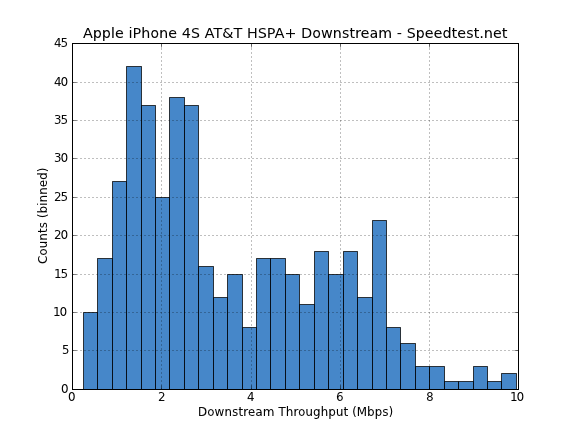
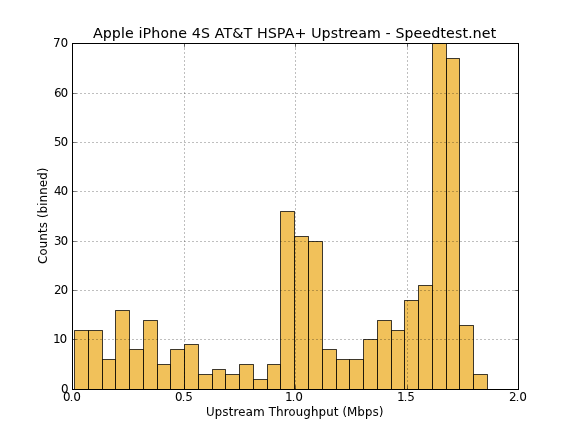

Verizon EVDO
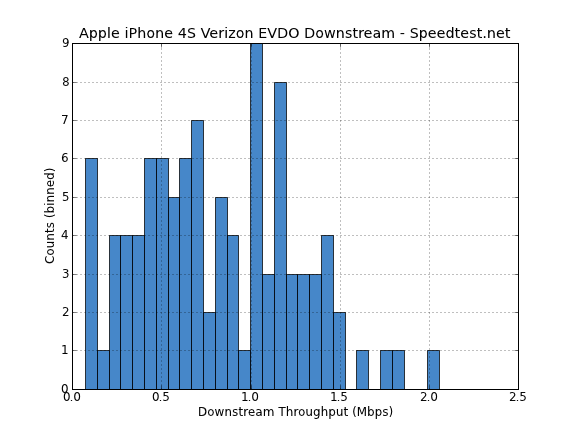
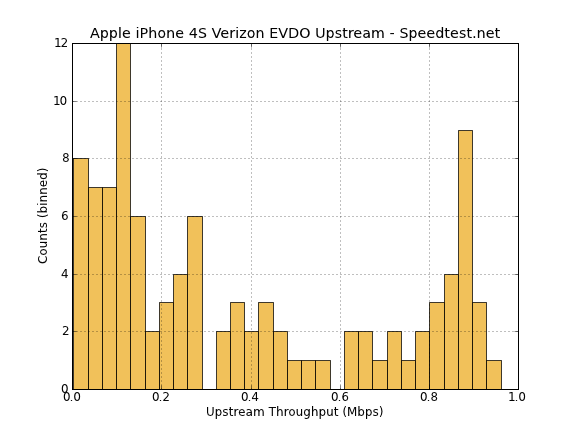

| iPhone 4S Speedtest Comparison | ||||||
| Carrier | AT&T | Verizon | ||||
| Avg | Max | Min | Avg | Max | Min | |
| Downstream (Mbps) | 3.53 | 9.94 | 0.24 | 0.82 | 2.05 | 0.07 |
| Upstream (Mbps) | 1.17 | 1.86 | 0.009 | 0.38 | 0.96 | 0.003 |
| Latency (ms) | 137 | 784 | 95 | 177 | 1383 | 104 |
| Total Tests | 457 | 150 | ||||
| Air Interface |
HSPA+ (HSDPA 14.4/HSUPA 5.76) |
EVDO Rev.A | ||||
For the CDMA carriers, the 4S shouldn’t (and doesn’t) bring any huge improvement to data throughput because the CDMA 4 had both receive diversity and MDM66x0. For users on GSM/UMTS, however, the 4S does make a difference again thanks to the inclusion of those two new features.
One of the things I noticed was absent on the CDMA iPhone 4 was the 3G toggle. It does indeed make some sense to not include this in a CDMA 1x/EVDO scenario since power draw is about the same between the two air interfaces, however, the absence of this toggle has carried over to the 4S regardless of whether the phone is activated on a CDMA2000 or UMTS/GSM network. That’s right, you can go under Settings -> General -> Network, and there’s no longer any 3G Data toggle which you can disable and fall onto EDGE (2G) with now.
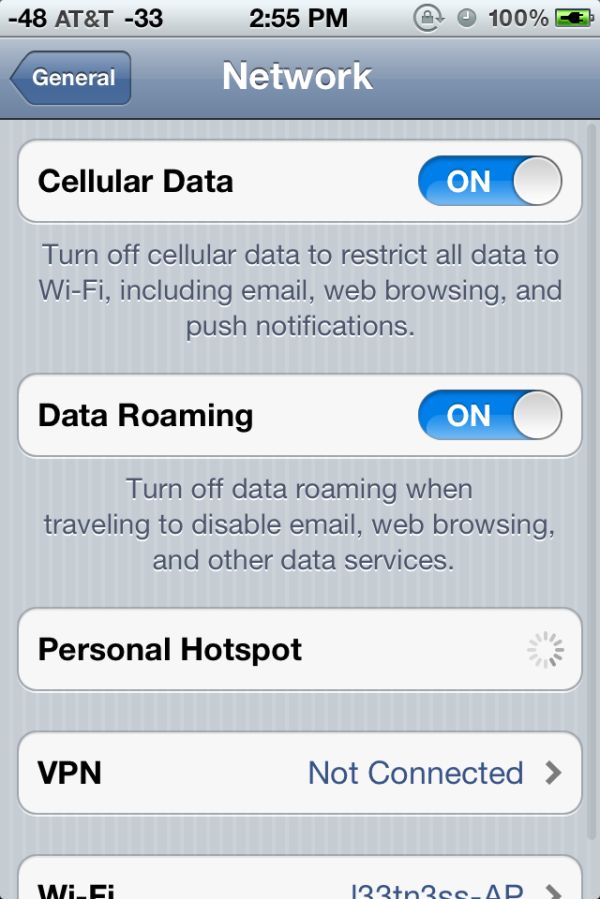
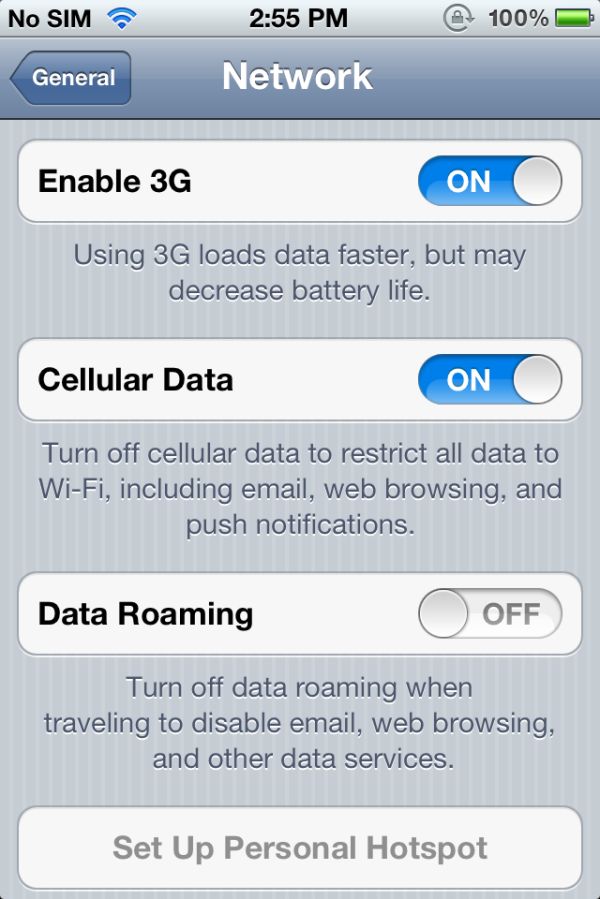
Left: iPhone 4S (no 3G toggle), Right: iPhone 4 (3G toggle)
It’s likely that this is absent to accommodate the multi-mode nature of the 4S (and thus the lowest common denominator CDMA mode), however the absence of this toggle makes getting connected in congested areas more difficult. In some markets, (I’m looking at you, AT&T in Las Vegas), EDGE is often the only way to get any connectivity, even without a major convention going on. Not having that 3G toggle makes manually selecting that less-used but more reliable connection impossible now, to say nothing of the potential battery savings that this would afford (and that we sadly can’t test now).
There’s one last tangential question about HSPA+ on the 4S, specifically on AT&T. I’ve left this to the end since it doesn’t impact non-US 4S users, but the last question is whether the 4S is actually on HSPA+. For a while, I was concerned that AT&T would continue using the wap.cingular APN on the 4S which seems shaped to around 7.2 Mbps HSDPA. I’m glad to report that AT&T hasn’t continued using wap.cingular on its 4S data plans, instead using “phone” which is a newer APN that allows for HSPA+ (above 7.2 Mbps) rates. You can check this yourself under PDP Context Info on the 4S in field test.


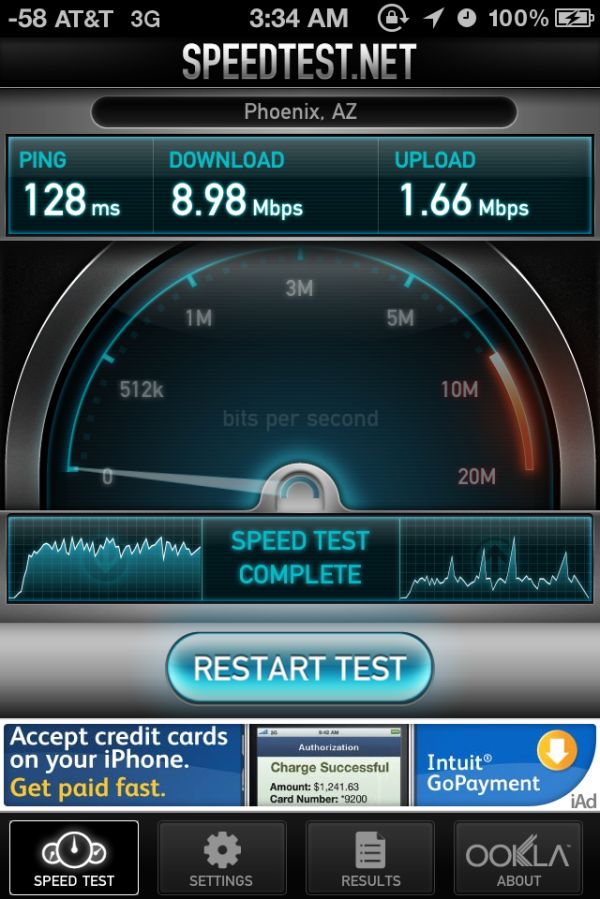
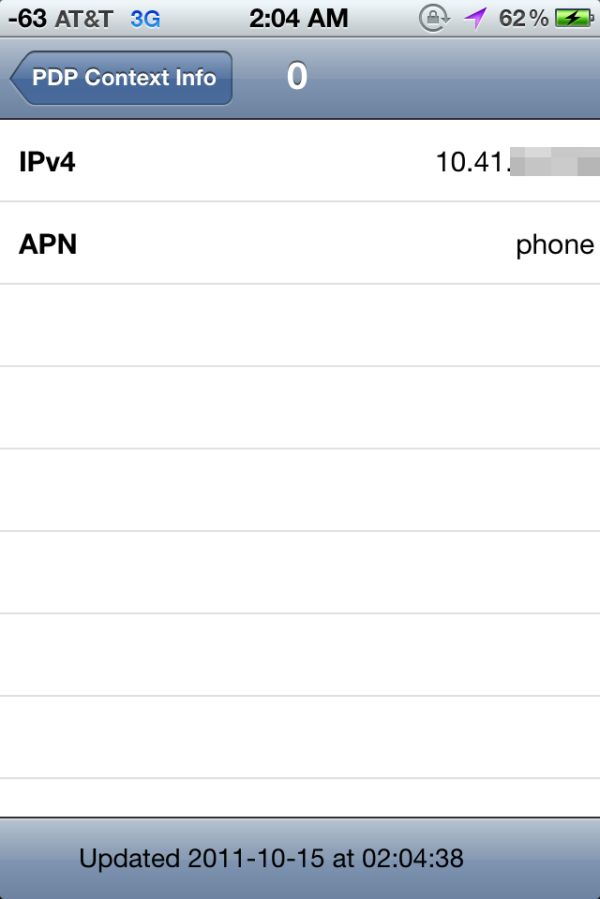








199 Comments
View All Comments
doobydoo - Friday, December 2, 2011 - link
Hardware wise, the difference between the iPhone 4S CPU/GPU combination and Android competitors, is huge.If you want the best performance, I don't see any other way to turn.
As for the software, I like most users would happily use Android or iOS - they've largely converged anyway.
name99 - Friday, November 4, 2011 - link
"If you had a 4 already your just a "moop" if you upgraded to one of these!"OK, so most US customers on on a 2yr plan. Upgrading for them is impractical, if for no other reason then for carrier reasons. And then you are COMPLAINING that Apple produced an upgrade that (in your eyes) gives them no reason to upgrade???
What exactly is your problem? You're like someone who goes to a restaurant and complains "the food sucks --- and the portions are too small".
dennykins - Tuesday, November 1, 2011 - link
Hey! I have that "Introduction to Modern Optics" book too! Pretty old, but still relevantname99 - Tuesday, November 1, 2011 - link
"It is admittedly curious that Apple hasn’t decided to make some other larger change to distinguish the 4S from the other two"There was, of course, also precious little visual change between iPhone, iPhone3G and iPhone 3GS. Likewise for plenty of other upgrades across the Apple line in the last ten years. I don't know why Anand thinks it's strange. For YEARS Apple has made the point that you buy an iMac --- and you get the what Apple thinks an iMac should be today. You don't buy an iMac XV371. You don't buy an iMac 7. You don't buy an iMac 20011. You buy an iMac --- which may or may not look like its predecessor, which may or may not have last been updated three, six or
nine months ago.
It's obvious that Apple wants to bring that same mindset to phones (and iPads). Screwing with people's expectations of an update in July was simply the first step in breaking the mindset of a particular schedule for upgrades. Of course there are issues that make it more difficult to do this cleanly, for example carrier involvement and the ridiculous subsidized pricing model --- which means that Apple has reason, at least for now, to keep older models around. But there are obvious advantages to Apple in switching to this model, including
- not being forced to release SW too soon. I think we'd all agree iOS5 was released under pressure, and that iOS 5.1 will be the release 5.0 should have been.
- Apple's been able to ignore pressure from a stream of constant Android updates for the past two years, but at some point annual upgrades may just be too slow. At that point it would be nice to have the option of minor upgrades (cf the recent PowerBook Pro upgrades), say boosting the CPU from 800 MHz to 1GHz, without it being a big deal --- something to shut up the crowd that looks at specs, while being ignored by the mass audience that does not care about specs and doesn't want Apple talking about them.
Not that this will stop haters from claiming that "people buy iPhones for fashion"....
KPOM - Tuesday, November 1, 2011 - link
Good observation about the upgrades. Yes, it's entirely possible we'll see minor spec bumps as the iPhone has become a staple of Apple's product line. We don't notice all the the upgrades in the Android world (how many people know or even care about the differences between the Galaxy S, Galaxy S II, and Galaxy S II Skyrocket ?), partly because they happen all the time.Also, Apple has never been a company to change the design simply for the sake of change. They tweak a design until they "get it right," but then stick with it a while. This year's MacBook Air, for instance, is a big update from last year's (Core i5/i7, backlit keyboard, 4GB RAM standard on most models), but they didn't change the external design. It's still selling extremely well and received good reviews. I think it's the same with the iPhone. The 4S has some significant improvements, from the faster processor, better camera, and better antenna.
name99 - Tuesday, November 1, 2011 - link
I'm glad you guys adopted my suggestion to report how snappy a phone feels, based not only on CPU benchmarks but also on the speed of flash, and things like the launch time of apps.In the spirit of constant complaint that is the web, can I now ask that you continue to do this for all future phones, not just iOS devices.
Yes, you have fanboi readers who care only about how wonderful their platform is; but you do also have a number of honest readers who are genuinely interested in things like how the speed of flash (including the speed of SD flash) varies across devices, and how launch times (for comparable apps) vary --- which, of course, depends on both HW and also SW/OS decisions.
Drasca - Tuesday, November 1, 2011 - link
There's a small typo that I'm surprised no one else has caught. Perhaps I am the only one that cares enough about this particular subject enough to. On the last page, 4th to last paragraph, we see:"we’ll hopefully see the technology mature into something more like what years of science fiction moves have promised us."
I believe you mean movies here.
I caught it in particular because I've been discussing amongst my friends how modern technology is the future promise of older science fiction. Oh gosh gee wiz, we have instant mobile communication across the globe, including video! We talk into our portable devices and they think for us. These devices are an extension of ourselves. In a way, we've become like the borg in that we're connected to community at large. Facebook is a form of hive mind group consciousness. Heck, we can track each other near-instantaneously and some folk are vividly aware of each other's locations.
These are interesting times, and what has only previously been explored as supposition has become reality.
I still want my flying cars and teleporters. Also, Holodecks and the AI behind it. Plus, the bridge of the starship enterprise D with its big comfy captain's chair and massive screen.
anishannayya - Wednesday, November 2, 2011 - link
If you want an iPhone, you really don't have a choice. Either you get the 4S or go find an Android phone.shashank7040 - Wednesday, November 2, 2011 - link
Asus Eee Pad being the first tablet With Slide out QWERTY........http://goo.gl/B4rJUthevibenow - Wednesday, November 2, 2011 - link
Check out our review of the Iphone 4shttp://www.youtube.com/watch?v=35v1kkaPM9s